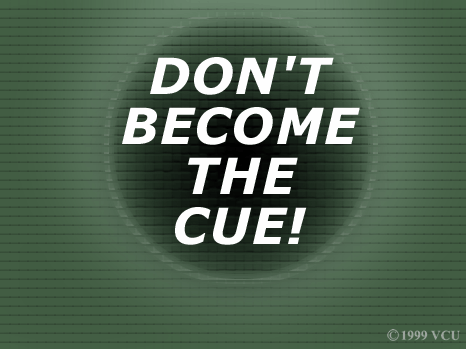
duration: 2 min. 14 sec
next slide
previous slide
slide menu
section
4
Lesson 4
Job Site Training - slide 4
Don’t become the cue
One thing that I would like to mention and caution you against before I forget it is inserting yourself as a cue to perform the task. Let me give you an example about what I mean by that statement. You are not going to be there hopefully for very long. Your idea is to get in, analyze the environment, identify the cues, and select an instructional approach that will quickly assist the person in being independent. However, inadvertently you may become a stimulus for the person to do the task.
For instance, one time the employment specialist came to me and said I'm teaching this individual how to vacuum; but whenever I leave the room, the person gets confused and misses entire sections of the room and doesn't seem to know what it is that he is supposed to do. I said let me come and I will have a look and see if we can come up with any ideas or some strategies to come up with to deal with this training issue. I went to the job site, and it really did not take me any longer than three seconds to see what was going on.
In actuality, what had occurred was that the employment specialist instead of instructing the task standing behind the worker; she had instructed the person standing in front of the worker. Whenever the individual got through a particular section of the room, she would inadvertently move to the next area where the person needed to vacuum. In fact, she had become a step in the task analysis or a cue for the person to visually attend to and had developed a systematic pattern of vacuuming the floor based on where the employment specialist's position was in the room. Therefore, when the employment specialist tried to fade out of view, the individual got completely lost because the employment specialist was a cue for performing that particular task.
I think that it is very critical for us to be extremely sensitive about whatever it is that we are doing when we are actually on that job site with the customer. Even turning your head towards a particular direction of an activity, looking toward an area where the person needs to go, smiling, frowning all are cues that the individual can quickly incorporate into his pattern for performing an activity. It is really critical for you to think about where your position is. Are you behind the person and are you providing as minimal of the amount of assistance and presence as possible to instruct the person to do the task successfully. These are the things that are very critical. You want to as quickly as possible set the person up for success and hopefully making the individual respond to what is in the workplace rather than keying into you as the employment specialist.
I would like to give you one more example before we move on from 'Don't become the Cue'. I saw someone assisting a young woman probably within the first day or two of being on a job site. This young woman had a significant physical disability and as a result, really used only one hand very effectively to perform the task that she was doing. The engineer had made her a very nice jig for her to use, which she was doing putting coupons on pizza boxes. The jig made it possible for her to peel off the stickers, grab a label, and put the coupon onto the pizza box all with one hand. However, how the employment specialist had positioned her in the work environment, she was really on the side that she did not use and that was where she needed to stack the pizza boxes. Because she could not transfer the pizza boxes to that hand and set it on the stack, the employment specialist had literally inserted herself into the task analysis and was taking the pizza boxes from this young woman and stacking the boxes.
This was maybe the second or third day on the job site, and I remember going in and saying, "You guys are doing great, but do you realize that you are step number 25 in the task analysis, because you are letting her hand you the boxes to stack". It was something so simple as to turn her table around so that the boxes could be stacked on the side of her wheelchair beside the hand that she was able to use successfully to complete the task.
You may have a little trouble visualizing what I am talking about here, but I think the concept is there for you. Don't inadvertently become part of the activity. Don't be the person that's doing any portion of that task. If you can't figure out how the person is going to use technology or learn how to do a step in the task independently, you need to go back to the drawing board and reanalyze what you are doing. If you are doing part of the task for the person, you have worked yourself into that job site.